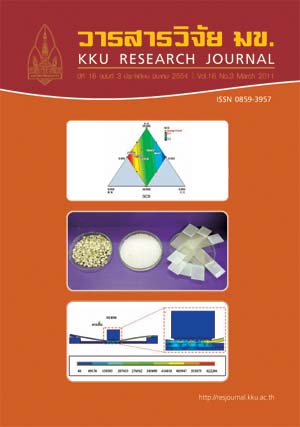Analysis of market structure and passenger transportation demand model between Thailand and Laos: case study of the customs house, Friendship Bridge, Nong Khai province
Main Article Content
Abstract
This study aims to examine the situation, general management and performance of in- ternational private transportation services of passengers between Thailand and Laos PDR at the at the Thai-Laos Friendship Bridge check point, Nong Khai Province. Other objectives are to analyze the market structure, competition behavior and the results of passenger transpor- tation industry’s performance. This study also aims to analyze the factors in uence passenger transportation demand and to propose the policy recommendations in order to enhance the ef ciency and performance development. Both primary and secondary data were obtained by the interviewing of two entrepreneurs chosen by purposive sampling and monthly data from July 2007 to June 2010 from the related public and private organizations. Entrepreneurs involved in this study consisted of international bus service, regular bus at the bridge and the hired van or bus.
The results show that there are two com- panies in an oligopoly market structure. The performance of both companies is nearly the same and ef ciency of performance measure- ments as well as technology application exists. The passenger transportation demand model estimation via unit root test prior to the ordinary least square (OLS) technique found that the passenger number has long term positive equilibrium relationship with the price. On the other hand, gross domestic product (GDP) and the frequency of services provided have negative relationship with exchange rate.
Analysis of Market Structure and Passenger Transportation 293 Demand Model between Thailand and Laos: Case Study of
the Customs House, Friendship Bridge, Nong Khai Province
The empirical results of short term analysis based on the error correction mechanism (ECM) estimation revealed that the adjustment speed that affects the number of passengers deviates from the equilibrium point to long term equilib- rium is 46.3 percent in each time period.
The policy recommendations for ef ciency and performance development are as follows:
1. Entrepreneurs should increase the frequency of services and number and variety of vehicles provide to the passengers.
2. Each vehicle should run at full capacity. 3. Improve the services to be more convenient in terms of the speed,
safety and ef ciency.
According to the ndings above, it can be con rmed that passenger income and the frequency of services are important factors determining the number of passenger. This conclusion is consistent with the demand theory. Moreover, the improvement of services quality and increasing ef ciency by entrepreneurs will lead to the tourism and investment promotion and the international transportation and economic growth of both countries.

